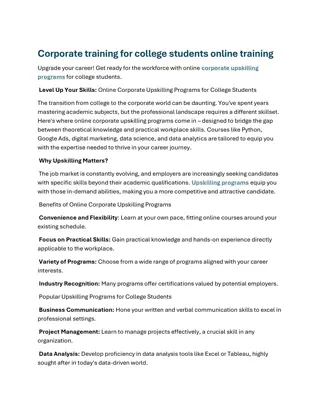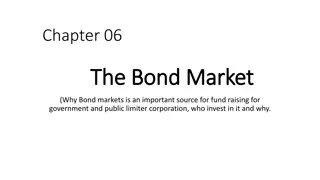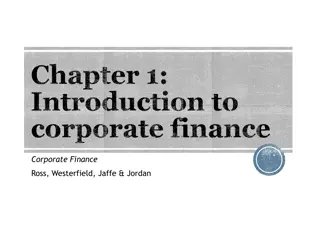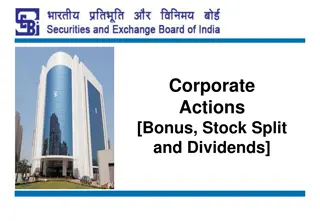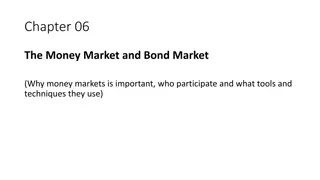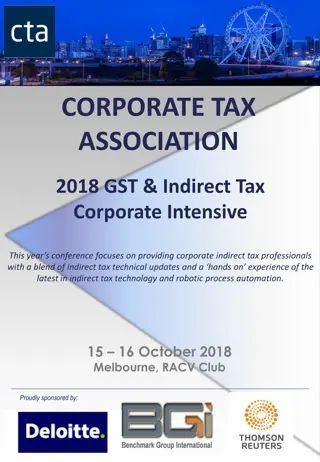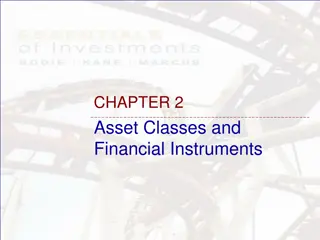Understanding Corporate Actions in Financial Markets
Corporate actions are important events that impact investors, such as dividends, rights issues, and more. Learn about the main categories of corporate actions, how they are expressed to investors through securities ratios, and examples like rights issues. Gain insight into the choices available to shareholders and how these actions can affect stock prices and shareholder holdings.
Download Presentation

Please find below an Image/Link to download the presentation.
The content on the website is provided AS IS for your information and personal use only. It may not be sold, licensed, or shared on other websites without obtaining consent from the author. Download presentation by click this link. If you encounter any issues during the download, it is possible that the publisher has removed the file from their server.
E N D
Presentation Transcript
CISI Financial Products, Markets & Services Topic Equities (4.1.5 and 4.1.6) Corporate Actions cisi.org
Corporate Actions What is a Corporate Action? Where a company does something that affects it s investors e.g. Shareholders These actions are generally agreed upon by the board of directors before being authorised by shareholders What are the main categories of Corporate actions? These classifications are used across Europe and by Euroclear and Clearstream (Both International Central Securities Depositories Investor has NO CHOICE Investor has an ELEMENT OF CHOICE Investor has a DEFINITE CHOICE to make Obligatory mandated by the company A DEFAULT OPTION is given to shareholders if they choose not to intervene by a particular date A DECISION MUST be made to choose between OPTIONS presented to them DOES NOT require any intervention from investors cisi.org
Securities Ratios Before we take a closer look at different examples of corporate actions, you need to know how corporate actions are expressed to investors. This is known as a securities ratio and it stipulates the terms of a corporate action (What the shareholder should expect from the company) It can be expressed in different ways depending on the type of corporate action: Nature of corporate action Dividends paid Giving new shares to existing shareholders Terms expressed as... Amount of dividends paid per share ( ) A ratio of the number of new shares received as a proportion of the number of shares owned. e.g. 1:4 (X new shares for each Y existing shares) This method is used in Europe and Asia In the USA the ratio is expressed differently: The first number in the ratio states final holding after the event; the second number is the original number of shares held. e.g. If the securities ratio is 5:4 and an investor holds 1,000 shares, after the event, the investor now owns 1250 shares compared with the 1000 they owned originally i.e. 1250:1000 cisi.org
Examples of a Corporate Action Rights Issue A company wants to raise finance: To expand To repay bank loans To repay bond finance An existing shareholder has pre-emptive rights to buy shares so that their proportionate holding is not diluted. Rights Issue Offer of new shares to existing shareholders ( Cash Call ) Shares are normally offered to existing shareholders at a discount to market price The initial response to the announcement of a planned rights issue will reflect the market s view of the scheme. Share prices can RISE or FALL as a result Shareholders Can react positively or negatively to the rights issue What can they do? Sell the rights to another investor (often transferrable known as renounceable ) Take up the rights buy the shares Do Nothing (Default option used) Sell sufficient rights to raise the cash to take up the rest cisi.org
Examples of a Corporate Action Rights Issue Completed Rights Issue Underwriters of a share issue agree, for a fee, to buy any portion of the issue not taken up in the market at the issue price. Shares They sell the shares they have bought when market conditions seem opportune to them (at a gain or a loss) The share price changes to reflect the effect of the rights issue once the shares go ex-rights (after the rights issue has happened) This is the point at which the shares and the rights are traded as two separate instruments The rights can be sold and the price for these rights is known as the premium. This adjusted share price is known as the theoretical ex-rights price (actual price will depend upon the interaction of buyers and sellers in the market at the time) (theoretical ex-rights price - price of a new share) In the case of Con Air plc 3.77 - 2.00 = 1.77 In the case of Con Air plc, the theoretical ex-rights price was 3.77 cisi.org
Examples of a Corporate Action Bonus Issue example securities ratio: 2:1 Scrip 2 new shares for every 1 existing AKA A company gives existing shareholders additional shareswithout paying anything Increases liquidity of share more buyers! Lowers the company share price Bonus Issue AKA Psychologically, a company s share price can become too high and less attractive to investors UK Cos. Like a share price under 10 Capitalisation Issue cisi.org
Examples of a Corporate Action Dividends The partof a company s profits passed to shareholders DIVIDENDS Interim Dividend First dividend declared by directors and paid halfway through the year Final Dividend Second dividend paid after approval by shareholders at the AGM, after the end of the financial year Many UK company s pay them twice a year Dividends per share may vary according to Overall company profitability Plans for future expansion SHAREHOLDERS Receive the dividends by: Cheque or Transfer straight into their bank accounts Transfer via CREST (system) cisi.org
Examples of a Corporate Action Receiving dividends When shares change hands, determining the correct person to receive dividends can be difficult Procedures have been put in place to prevent mistakes in paying dividends to the wrong person SHAREHOLDERS Shares are bought and sold with the right to receive the next declared dividend up to the date shortly before the dividend payment is made. Ex-dividend (without) Cum-dividend (with) If the shares are purchased cum-dividend, the purchaser will receive the declared dividend. At a certain point between the declaration date and the dividend payment date, the shares go ex- dividend. Buyers of shares are not entitled to the declared dividend. THURSDAY is Ex-Dividend day (Buying ex-dividend means shares fall in price by 8p Standard settlement period across Europe is T+2 (A trade will be settled two business days after it is executed) cisi.org
Cum and Ex Dividend Example Holding plc calculates its interim profits (for the six months to 30 June) and decides to pay a dividend of 8p per share. Holding plc announces ( declares ) the dividend on 1 September and states that it will be due to those shareholders who are entered on the shareholders register on Friday 7 October (Record date, register date or books closed date). (The actual payment of the dividend will then be made to those shareholders at a later specified date.) Given the record date of Friday 7 October, the LSE sets the ex-dividend date as Thursday 6 October. Ex-Dividend Date On this day, the shares will go ex-dividend and should fall in price by 8p. This is because any new buyers of Holding plc s shares will not be entitled to the dividend. Record Date Register Date Books Closed Date The actual payment of the dividend will then be made to those shareholders on the register at the record date at a later specified date, say Wednesday 22 October. cisi.org
Examples of a Corporate Action Takeovers A company can grow organically or take a different route buy other companies TAKEOVER The predator company is under an obligation to report their share purchases once they reach a certain percentage Predator Company (company bidding to buy another) Target Company (company bid for) Hostile Takeover Friendly Takeover Directors of the target company consider the offer not attractive. They recommend that their shareholders reject the offer. Shareholders of the target company can choose whether to accept or reject the bid, a hostile takeover bid can still be successful Success = predator company gains control by buying more than 50% of the shares of the target company Directors of the target consider the takeover bid to be acceptable, and recommend acceptance to cisi.org shareholders.
Examples of a Corporate Action Mergers MERGER Company one Company two The two companies agree to merge their interests. In a merger it is usual for one company to exchange new shares for the shares of the other entity Forms 1 single large company cisi.org
Corporate Actions Overview Action taken by the company Dividend payment Description Category of corporate action Shareholders receive payments (normally twice a year) based on company profits Mandatory The Board issues new shares to existing shareholders for free, generally to increase liquidity of shares so that the share price falls. Bonus/Scrip/ Capitalisation issue Mandatory The Board issues new shares to existing shareholders (First option) at a discount their market price to raise finance Rights issue Mandatory with options Two companies agree to merge their interest to form one larger to company Merger Voluntary A predator company bids for a target company and aims to buy the majority of shares in the target. A take-over can either be friendly (target shareholder approval) or hostile (target shareholder rejects) Take-over Voluntary cisi.org





